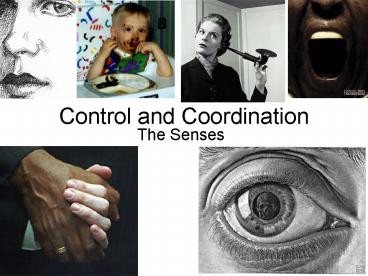Control and Coordination - PowerPoint PPT Presentation
1 / 26
Title:
Control and Coordination
Description:
Vision - Light stimulates rods (dim light) and cones (colors) and sends impulse to brain. ... b. Middle ear eardrum vibrates and stimulates (hammer, anvil, stirrup) ... – PowerPoint PPT presentation
Number of Views:27485
Avg rating:5.0/5.0
Title: Control and Coordination
1
Control and Coordination
- The Senses
2
- Light rays, sound waves, heat, chemicals or
pressure in your environment stimulate your sense
organs
3
- Five senses
- Vision - Light stimulates rods (dim light) and
cones (colors) and sends impulse to brain.
Sometimes you can confuse the brain with
illusions like these.
4
(No Transcript)
5
- Hearing Parts of the Ear and how we hear
- a. Outer ear - gathers sound waves
- b. Middle ear eardrum vibrates and stimulates
(hammer, anvil, stirrup) - c. Inner ear fluids in
- the cochlea vibrate and
- send impulse to brain
6
(No Transcript)
7
- 3-4. Smell and Taste work closely together
- Molecules in air stimulate nerve cells -
olfactory cells in nasal passages and taste buds
on tongue
8
(No Transcript)
9
(No Transcript)
10
- 5. Touch - found in organs and skin and pick up
changes in pressure, pain, and temperature
11
(No Transcript)
12
Control and Coordination
- The Nervous System
13
- Nervous system
- receives and responds to information about what
happens inside and outside of body - Stimulus - any change that brings about a
response (reaction) - maintains homeostasis
14
- Neuron cell that carries information (nerve
impulse) through the body - Has three parts
- - Cell body (C) contains nucleus
- - Dendrites (B) carries impulse toward cell
body - - Axon (A) carries impulse away from cell body
15
- Three types of neurons
- Sensory neuron receives information from senses
- Interneuron carries impulse from sensory neuron
to motor neuron - Motor neuron sends impulse to muscle for action
16
- How impulses travel
- - Nerve cells do not touch
- Synapse - a space between nerve cells
- When an impulse reaches the end of an axon, a
chemical is released that moves across the
synapse to the dendrite of the next neuron
17
- Central nervous system (CNS) - made up of brain
and spinal cord - The brain is the control center of the body
18
- Brain
- Cerebrum - interprets impulses from senses,
processes thoughts, stores memories, and controls
movement
19
- 2. Cerebellum coordination and balance
20
- 3. Brain stem - controls involuntary muscles
(ex. heartbeat, breathing, and blood pressure)
21
Spinal cord - links brain with peripheral nervous
system. Controls reflexes. Protected by
vertebrae.
22
- Peripheral nervous system (PNS) nerves branch
from CNS (brain/spinal cord) to body
- Somatic N.S voluntary actions
- - Autonomic N.S involuntary actions (reflexes)
23
- Drugs like alcohol and caffeine affect your
nervous system - Alcohol slows the activities of the central
nervous system - Caffeine speeds up the activity of the central
nervous system
24
- Olny srmat poelpe can
- I cdnuolt blveiee that I cluod aulaclty
uesdnatnrd what I was rdanieg. The phaonmneal
pweor of the huamn mnid, aoccdrnig to rscheearch
at Cmabridge Uinervtisy, is it deosnt mttaer in
what order the ltteers in a word are, the only
iprmoatnt thing is that the frist and lsat ltteer
be in the rghit pclae. The rset can be a taotl
mses and you can still raed it wouthit a porbelm.
This is bcuseae the haumn mnid deos not raed
ervey lteter by istlef, but the wrod as a wlohe.
Amzanig huh? Yaeh and I awlyas tghuhot slpeling
was ipmorantt!! - 1. Why is it that the human brain is able to
read the above passage? - 2. What do you think the above passage says
about the importance of spelling words correctly
for human understanding? - 3. Do you think your language arts teachers
would be swayed into believing that spelling is
unnecessary in their class? Why or why not?
25
- Title Reaction Time
- Purpose To determine reaction time by measuring
how long you take to catch a falling ruler. - Procedure During two separate tests, you will
catch a falling ruler released by your classmate
using your thumb and forefinger. In one test,
you will focus on catching the ruler. In the
other, you will be distracted with doing
multiplication in your head while trying to catch
the ruler. - Hypothesis Will your reaction time be faster
during normal conditions or distracted
conditions? Why? ___________ - _____________________________
26
- Conclusions
- What is meant by reaction time?
- What is your average reaction time in seconds
under normal conditions (no distraction)? Under
distracted conditions? - Under which condition (undistracted or
distracted) was your average reaction time
shorter? Why do you think this happened? - Does any student have a reaction time of zero?
Why might this be an unusual thing? - What is the stimulus in this experiment? What is
the response?

